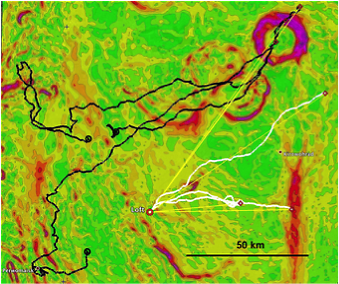[Seminar] 'A novel hypothesis for large-scale animal navigation: the gravity vector hypothesis and confirming experimental data using GPS tracking of homing pigeons' - Prof. Hans-Peter Lipp

Date
Location
Description
Physics and Biology Unit would like to invite you to a seminar by Prof. Hans-Peter Lipp.
Speaker
Hans-Peter Lipp, Ph.D.
Professor Emeritus, University of Zurich
Title
A novel hypothesis for large-scale animal navigation: the gravity vector hypothesis and confirming experimental data using GPS tracking of homing pigeons
Abstract
A major unsolved problem in biology is the amazing ability of long-distance navigation in migratory birds, homing pigeons, sharks, whales, albatrosses and many other species traveling long distance below and above the surface the globe. This ability requires that animals can calculate their actual position on the globe from local information only. Textbooks explain this by the use of the earth’s magnetic field, because many animals sense it. However, the best information deduced from the global magnetic field is latitude (the position between equator and pole), but the magnetic field does not help for sensing the longitude (position along the equator). Thus, the magnetic field is useful as a compass but not for sensing position. A theory by the Ukrainian physicist Valerii Kanevskyi postulates that long distance migrators or homing pigeons are born with cells in their brain or other body tissue that act as neuronal gyroscopes remembering the gravity vector at their place of birth. Gyroscopes (rapidly spinning discs) are still used in large airplanes and space missiles to measure their displacement from the place of activation, by comparing the actual gravity vector against the (mechanically) remembered one. Thus, by simple spherical trigonometry, a displaced animal knows always the distance and direction to home, and can build up a cognitive navigational map during life. We have tested this seemingly simplistic theory and found, surprisingly, that it can explain and predict the homing behavior of pigeons released in and around gravity anomalies. If the theory really holds, it might also explain the behavior of animals moving out of earthquake zones prior to the earthquake, and could help in understanding some mysterious effects of the gravity field of sun and moon on life on earth. It might also open new perspectives in biology.
Host
Jonathan Miller/Michael Kuba, Physics and Biology Unit
Prof. Lipp will be visiting OIST for December 12-13. He is an expert in the fields of adult neurogenesis in mammals, and automated behavioral phenotyping of rodents. If you would like to meet with Prof. Lipp during his OIST visit, please contact Midori Tanahara (midori.tanahara [at] oist.jp).
Subscribe to the OIST Calendar: Right-click to download, then open in your calendar application.



